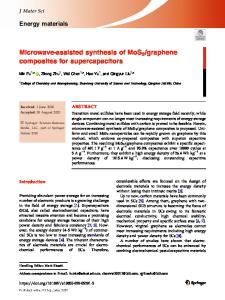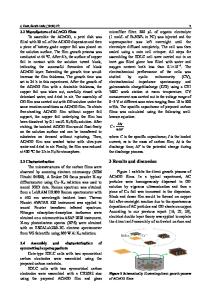Dynamic Air-Brush Deposition Method for the New Generation of Graphene Based Supercapacitors
- PDF / 1,233,596 Bytes
- 6 Pages / 432 x 648 pts Page_size
- 53 Downloads / 327 Views
MRS Advances © 2018 Materials Research Society DOI: 10.1557/adv.2018.65
Dynamic Air-Brush Deposition Method for the New Generation of Graphene Based Supercapacitors 1
Paolo Bondavalli, 1Gregory Pognon, 2Elias Koumoulos, 2Costas Charitidis
1
Chemical and Multifonctional Materials Laboratory, Thales Research and Technology, 2School of Chemical Engineering NTUA Department of Materials Science and Engineering, National Technological University of Athens
ABSTRACT
This contribution deals with the fabrication of a new generation of supercapacitors for harsh environment (avionics) based on nanostructures layers fabricated by spray-gun deposition method. Thanks to the fabrication of electrodes using spray-gun and the utilization of specific ionic liquids developed at Thales, we were able to achieve a capacitance of 20F/g (for a whole cell) and a power of 40kW/kg using carbon nanofibres (CNFs) mixed with reduced graphene oxide (RGO). These results are not the higher values obtained in literature but they are extremely interesting considering that the final device needs to stand temperature between -55°C and +105°C for avionics applications and that no commercial supercaps in the world are able to work in this interval. Only using these ionic liquids and the specific electrodes, it is possible. These supercapacitors were fabricated using spray-gun deposition method which is an extremely interesting technique from an industrial point of view considering that it can be easily implemented in roll-to-roll fabrication.
INTRODUCTION Supercapacitors are electrochemical energy storage devices that have the high powerdelivery-capability of conventional capacitors [1,2]. Indeed Supercapacitor is only a commercial name given by NEC in 1971. The real name of these devices is Electrical Double Layer Capacitors considering that the energy is stored in a non-Faradic way, without redox reaction as in case of batteries, in the double layer built-in between the electrodes and the charges in electrolyte after applying a bias. Since they are able to deliver higher power and achieve longer cycle life than batteries, EDLCs have been developed to provide power pulses for a wide range of applications such as electric transportation technology (e.g., hybrid electric vehicles (HEVs) and plug-in HEVs), electric utility industry (e.g., emergency backup power and grid system stability improvement), consumer electronics (e.g., laptops, cell phones, pagers, and video cameras), medical electronics (e.g., portable defibrillators, drug delivery units, and neurological stimulators) and military/defense devices (e.g., communication devices, unmanned aerial vehicles, spacecraft probes and missile systems). The first patent related to EDLC was issued in 1955 by General Electric [3]. The rising of interest for nanomaterials at the end of the nineties, dramatically increased the interest for these devices considering that thanks to these new materials a large panel of new large market applications, and new functionalities, could be targeted. In this contribu
Data Loading...










